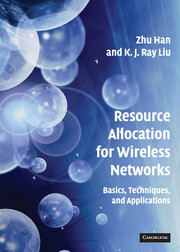1 - Introduction
Published online by Cambridge University Press: 05 August 2012
Summary
Over the past decade, there has been a significant advance in the design of wireless networks, ranging from physical-layer algorithm development, medium-access control (MAC) layer protocol design, to network- and system-level optimization. Many wireless standards have been proposed to suit the demands of various applications. Over time, researchers have come to the realization that, for wireless networks, because of fading channels, user mobility, energy/power resources, and many other factors, one cannot optimize wireless communication systems as has been traditionally done in wired networks, in which one can simply focus on and optimize each networking layer without paying much attention to the effects of other layers. For wireless networks, cross-layer optimization is a central issue to ensure overall system performance. Yet resource allocation is one of the most important issues for cross-layer optimization of wireless networks.
For instance, across different layers, one cannot design physical-layer coding, modulation, or equalization algorithms by assuming that the MAC layer issues are completely perfect, and vice versa. There are also user diversities—different users at different times and locations may suffer different channel conditions, and therefore may have different demands and capability. Fixing and allocating bandwidths and resources without considering such user diversity can simply waste system resources, and thus performances. In addition, in wireless networks there are space, time, and frequency diversities as well. Taking advantage of those diversities can significantly improve communication performance. All those factors contribute to the need of careful consideration of resource allocations.
We have witnessed the advance of resource allocation in recent years with tremendous progress.
Information
- Type
- Chapter
- Information
- Resource Allocation for Wireless NetworksBasics, Techniques, and Applications, pp. 1 - 6Publisher: Cambridge University PressPrint publication year: 2008
